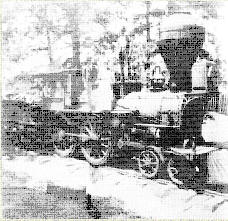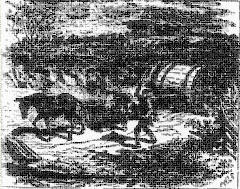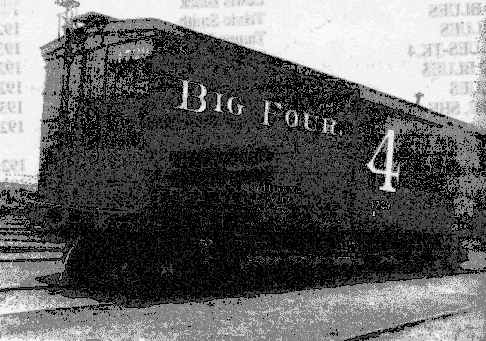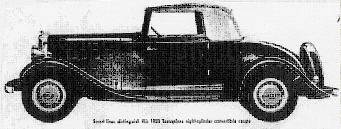
Painting © 2004 Loz
Arkle
Website
© Copyright 2000-2011 Alan White - All
Rights Reserved
Site optimised for Microsoft Internet Explorer



“Now Look-A Here, Blues. I Wanta Talk To You”* by Max Haymes
(* “Conversation With The Blues” Big Bill. 1941)
Running boards
On a November day in 1936 a youthful Robert Johnson leaned over his guitar and sang:
“Me an’ my baby bought a Vee-8 Ford;
Well, we wound that thing all on the runnin’ board, yeah” (1)
Johnson may have been aware of a Blind Willie McTell record made some 3 years earlier.
“When you see my mama standin’ in the do’;
Papa wound up an’ mama won’t go.”
Refrain: “You got to warm it up to me, now;
You got to warm it up to me.
Papa’s rod hot, mama got to get ‘im cold.”“When she’s struttin’ a Cadillac, a Southern Ford;
She does her struttin’ on the runnin’ board.”
Refrain: “You got to warm it up to me,” etc. (2)
This in turn drew on a recording made by Big Bill Broonzy and Frank Brasswell, “Papa’s Gettin’ Hot” (Ch 16015) from 1930. Although Brasswell, the lead singer on this occasion, does not include the running board verse.
From New Orleans an extract appeared in the De Bow Review of 1853 which referred back to the times before the steamboat had “exerted its magical influence on the western (i.e. southern) waters,”. Written by a Dr. Monette of a time around the beginnings of the 19th century, he said “the rich cargoes which ascended the Mississippi in keel boats and barges were propelled by human labor for nearly two thousand miles, slowly advancing against the strong current of these rivers. The boatmen, with their bodies naked from the waist, spent the long and tedious days traversing the ‘running board’, and pushing with their whole force against their strong setting-poles, firmly fixed against the shoulder.” (3) A more detailed account appeared some 30 years later. “‘Poling’ consisted of pushing the boat up stream by the aid of long poles. The men successively took their places at the bow and firmly resting their poles on the bed of the river, walked towards the stern pushing the boat forward. Whenever a man reached the stern, he pulled up his pole and ran rapidly back to resume his place in the line. Hence the spaces on each side of the boat where this constant circuit was going on were called ‘running boards’.” (4)
The running board continued into the railroad era. This enabled some maintenance and care of the steam engine, such as topping up with tallow (Footnote 1) from the fireman’s tallow pot. “The fireman. . . was the man who crawled out of the cab onto the locomotive’s running board as the train coasted downgrade, and edged precariously along the side of the hot boiler to fill the cylinder cups with hot tallow.” (6) Running boards on a standard U.S. 4-4-0 engine (see pic.) “are made of ash (wood) 2 ½ inches thick, supported on wrought-iron brackets bolted to the boiler. The outside edges of the running-boards are bound with brass.” (7)

Fig. 1: “The first locomotive on the Minden Tap, a
precursor of the Louisiana & Arkansas Railway which eventually became part of
the Kansas City Southern (of Flying Crow fame). Note the running board
supporting the ‘elegant couple’. The lady appears to be wearing a version of a
Mother Hubbard; April, 1890.”
Mother Hubbards
These same running boards re-appeared on earlier automobiles. The main function presumably was the role of a platform or ‘stepping stone’ to enable ladies to gather up their long skirts before descending on to often, very muddy streets. Certainly in the 19-teens and ‘20s in the South, black and white women wore the long, loose-fitting dress known as a ‘Mother Hubbard’ (from the nursery rhyme character) as part fashion and part dictate by the religious leaders in both communities. The hem reaching down to the ground. But by the mid-1920s many young women were rebelling against this puritanical fashion; including the Blues singer. As shown in the floating verse incorporated by Clara Smith in her smouldering “Whip It To A Jelly”
“I wear my skirts up to my knees;
An’ whip that jelly with who I please.
Refrain:
“Oh! Whip it to a jelly—mmmmm; Mmmmm—mmmmm—mmmmnim.” (8)
Fig.2: “The car that featured on Robert Johnson’s only commercial ‘hit’: “Terraplane Blues”
A couple of titles by male singers indicated that Clara Smith was bang up to date in fashion. Frank Stokes recorded his “Nehi Mamma Blues” in 1928 and Blind Joe Reynolds cut “Nehi Blues” the following year. It was a reference by tough Cincinnati-based pianist ‘Jesse James’ to ‘loose Mother Hubbards, in the stocking feet’ in 1936 that betrayed him as a ‘long-time man’ in prison where Decca recording executives found him. Rising hemlines had been in vogue for over a decade by the time he cut his hard-hitting version of “Casey Jones” with pounding piano.
“When the news reached town (that) Casey Jones was dead;
Women went home an’ outed out in red.
Slippin’ an’ slid in’ across the streets;
With loose Mother Hubbards, in the stocking feet.” (9)
Hay
“To sleep on the job”. (10) “a bed.. .tramps c(ant): 1925.. “hit the hay”, to prepare to sleep” (11). The cool 12-string guitarist Barbecue Bob who was based in Atlanta for his recordings, include these lines on what is probably his most popular (and finest) blues.
“Yellow man won’t quit, black man just won’t hay;
Yellow man won’t quit and a black man just won’t hay.
But a pigmeat mama crazy ‘bout brownskin baby ways.” (12)
Also see Bob’s “Just Won’t Hay” on 11/4/29. Although the yellow and black man have the stamina, ‘all night long’ to impress their women; Bob (as a ‘brownskin’) is superior in his style of loving. in “Just Won’t Hay” the sense is that his feelings/desire just won’t keep until next morning; it won’t let him sleep.
Mooching
“Begging: tramp’s and beggars (slang) 1879, Thor Fredur, “Sketches from Shady Places”. (13)
Sang Bob in 1930:
“You started in to moochin’, but your moochin’s in vain. (x 2)
Be careful with yourself, you’ll get a ball an’ chain.” (14)
It was illegal to beg - in most places - especially if you were black, in the South during the early decades of the 20th century.
Behind
“afterward; that which follows” (15)
Once again, Barbecue Bob dropped his head an’ went to singin’ an’ cryin’.
“I’m kind-a worried, got something on my mind. (x 2)
That’s why I drink my whisky, make my sorrow ache behind.” (16)
In other words, feel low later on - when you get sober.
Blind Pig
A name for a speakeasy in Georgia during Prohibition (1920-1933). Patrons entered a side door down the alley that was separated from the main street. The inside was separated from the main bar by a partition - nobody (who shouldn’t) could see in to the blind pig. Also known as ‘blind tigers’ in Mississippi.
“Blind pig, blind pig, sure glad you can’t see. (x 2)
Well, if you could, it would be too tight for me.” (17)
Rolling
In the 17th century “good roads were unknown and wagons were few.” Tobacco was collected, cured and then packed into hogsheads, a kind of large cask or barrel. To transport it “. . . a pole and whipple trees were attached to each hogshead by an iron bolt driven into the centre of one head, thus converting the cask into a huge roller.” Bolles adds “For many years the places for deposit and inspection of tobacco were called ‘rolling houses’. (18) And in Jonestown, Md. c. 1820s, “Huge hogsheads of tobacco, stoutly hoped, and with an axle driven through the middle so as to form a huge roller, and drawn by horses driven by negroes, were trundled over what are still known (c. 1880s) as “rolling roads” to town;” (19) In the 1820s Jonestown was changed to Baltimore after an early Maryland governor, Lord Baltimore.

Fig.3: “Method of transporting tobacco in the South
c.1840, before railroads began to spread. Probable origin of ‘rolling’ to mean
working, and later on, making love.”
This seems the most likely origin to date for ‘rolling’ to equate with working (before it came to mean making love and easily adopted by Blues singers as ‘biscuit roller’ or dough roller’ etc.). It was used in its original meaning by superb slide guitarist Blind Joe Reynolds from Lake Providence, La. on the Mississippi River. This was across from Tallula, Miss. in Issaquena County, equi-distant between Greenville and Vicksburg.
“You married men oughta keep your wives at home;
Say, you married men oughta keep your wives at home.
That’s your job, roll for the Man an’ try to carry your labour home.” (20)
Around 7 years later Robert Johnson also used the term in its work sense. He doesn’t see the sense of doing shift work out in the cold weather when there are “icicles on the trees” when he doesn’t have a woman in his life.
“I’m a steady rollin’ man, roll both night an’ day;
I’m a steady rollin’ man, ooh-hmm! I roll both night an’ day.
An’ I haven’t got no sweet woman, mm-boys, to be rollin’ this-a way.” (21)
Stem winder
This term refers to the early manual braking system on U.S. trains, both freight and passenger. The job was done by brakesmen who were sometimes African Americans. It was hard and often dangerous work. The brake(s) man had to ride the top of the box cars and when required had to apply his hands to the wheel of each individual vehicle in turn. Apart from the swaying of the train, weather conditions could be freezing and blinding rain often obscured vision when he was trying to look out for on-coming bridges or tunnels. Needless to say there were often fatal accidents.

Fig.4: “Although boasting the legend “Air Brake” on
its side, this box car (1901) of the Cleveland, Cincinnati, Chicago & St. Louis
Railway, still sports a stem winder on the rear. The CCC. & St. L. was popularly
known as the ‘Big Four’ and was celebrated by Leroy Carr in 1934 on his “Big Four
Blues” for Vocalion.
Wheels replaced levers for hand brakes on freight cars some time around 1850. “Some were mounted on the end of the car, while others were fastened to tall staffs that reached above the roofline. The wheels themselves were always spoked.” (22) By the late 1860s the Westinghouse air brake was patented. This was a system that applied brakes to the whole train at the same time. Although not the inventor of the air brake, George Westinghouse combined earlier ideas for the first practical example, between 1868-1869. “His.. .creation was a lucky combination of trial or obvious elements necessary for a pneumatic train brake.” (23) Due to the teething troubles, competition from other brake systems, and most of all the railroad companies’ resistance to the high initial cost of the air brake on thousands of box cars; the Westinghouse system did not become “standard equipment (on) the American freight car until 1900.” (24) But some railroads still balked at the cost of installing air brakes on their freight trains. In the case of the L. & N. they “were not installed on all the cars until 1914. (25)
But as White observes “Actually, brakemen of the old sort (i.e. mechanical/manual operators) did not disappear entirely with the adoption of the air brake.” (26) The old manual staff brakes were retained on freight cars” as backups in case of an air brake failure. In addition, some manual braking was routinely done to save wear and tear on the air brakes.” (27) The staff brake was known as a ‘stem winder’ and Blind Boy Fuller soon adapted the persona (?) of this device as a boast of his sexual prowess.
“My gal say ‘You can treat me mean, and you can treat me low;
But every time I see you, know I wanna wind some more’.”
Refrain:
“Says, I’m a good stem winder; Yeah, I’m a good stem winder.
Says, I’m a good stem winder, please bring your work to me.” (28)
The stem winder consisted of a vertical rod and a wheel at the top of the rod for the leverage to wrap the brake chain around the vertical rod to stop or secure the car. A paul was provided to hold the brake applied.” (29) A paul is” A short bar preventing a capstan, etc. from rolling back”. (30)
References
| 1. “They’re Red Hot” | Robert Johnson vo.gtr. speech. 27/11/36. San Antonio, Tex. |
| 2. “Warm It Up To Me” | Blind Willie McTell vo.gtr. speech; Curly Weaver vo.gtr. 14/9/33. New York City. NY. |
| 3. DeBow J.D.B. | “The Industrial Resources, etc. of the Southern & Western States. Vol.111. On microfilm from British Lending Library. Originally published at the Office of De Bow’s Review, Merchant’s Exchange, New Orleans, 1853. p.457. |
| 4. Scharf Thomas | “History Of Saint Louis City & County”. Vol.2. On microfilm, ibid. Originally published by Louis H. Everts & Co. Philadelphia. 1883. p.1090. |
| 5. Patterson R.F. (Ed.) | “The Cambridge English Dictionary”. Tophi Books. 1990. p.413. |
| 6. Baker Stanley L. & Virginia Brainard Kunz | “The Collectors’ Book Of Railroadiana”. Castle Books. Sept. 1979. p.161. |
| 7. White John H. Jr. | “American Locomotives-An Engineering History, 1830-1880”. The John Hopkins University Press. Baltimore & London. 1997. (Rev. ed.). 1st pub. 1968. p.565. |
|
8. “Whip It To A Jelly”
|
Clara Smith vo. humming; Lemuel Fowler pno. 25/2/26. New York City. NY |
| 9. “Southern Casey Jones” | Jesse James vo.pno. 3/6/36. Chicago, Ill. |
|
10. Adams Ramon F.
|
“Language of the Railroader”. University of Oklahoma Press. Norman. 1977. p.75. |
|
11. Partridge Eric
|
“A Dictionary Of The Underworld”. Wordsworth Edition. 1989. (Rep.). 1st pub. 1950. p.323. |
| 12. “Chocolate To The Bone” | Barbecue Bob vo,gtr. 13/4/28. Atlanta, Ga. |
| 13. Partridge. | Ibid. p.448. |
| 14. “We Sure Got Hard Times Now” | Barbecue Bob vo.gtr. 18/4/30. Atlanta, Ga. |
|
15. Major Clarence
(Ed.)
|
“Black Slang”. Routledge & Keegan Paul. London & New York. 1987. (Rep.). 1st. pub. 1970. p.25. |
| 16. “Blind Pig Blues” | Barbecue Bob vo.gtr. 13/4/28. Atlanta, Ga. |
| 17. Ibid. | |
|
18. Bolles Albert S.
|
“Industrial History Of The United States”. Augustus M. Kelley. New York. 1966. (Rep.). 1st pub. 1881. p.7. |
|
19. Bryant William
Cullen (Ed.)
|
“Picturesque America” Vol.2. Centennial Edition. (From “Baltimore And Environs”. J . C. Carpenter.) Lyle Stuart Inc. N.J. 1974. p.100. |
| 20. “Outside Woman Blues” | Blind Joe Reynolds vo.gtr. humming.c.-/1 1/29. Grafton,Wis. |
| 21. “I’m A Steady Rollin’ Man” | Robert Johnson vo.gtr. 19/6/37. Dallas. Texas. |
|
22. White John H. Jr.
|
“The American Railroad Freight Car” (From the Wood-Car Era to the Coming of Steel). The John Hopkins University Press. Baltimore & London. 1995. (Rep.). 1st pub. 1993. p.528. |
| 23. Ibid. | p.539. |
| 24. Ibid. | p.546. |
|
25. Cline Wayne
|
“Alabama Railroads”. The University of Alabama Press. Tuscaloosa & London. 1997. p.161. |
| 26. White. | “Freight Car”. Ibid. p.530. |
| 27. Ibid. | |
| 28. “I’m A Good Stem Winder” | Blind Boy Fuller vo.gtr. 6/4//38. New York City, NY. |
| 29. Unknown author. pavel.physics.sunysb.edu/RR/Railroad Definitions. | “Glossary-445 Railroad Related Terms”. 2000. p.25. |
| 30. Patterson. | Ibid. p.297. |
All transcriptions by Max Haymes.
All discographical details from “Blues & Gospel Records 1890-1943” (4th ed.) Revised. Robert M. W. Dixon, John Godrich, & Howard Rye. Clarendon Press. Oxford. 1997
Included in a forthcoming book “Railroadin’ Some”* is a more lengthy and fully detailed discussion of meanings in pre-war blues connected to the railroads; such as ‘riding the rods’/’blinds’, ‘highball’/‘balling the jack’, ‘smokestack lightning’, ‘yellow dog’, ‘hotshot’, et al. Also includes chapters tracing blues piano/boogie woogie to its starting place and a Blues ‘journey’ on the M. & O. RR. from Mobile, Ala. to St. Louis, Mo. Featuring around 100 Blues transcriptions as well as many illustrations of the Blues and railroads.
* “Railroadin’ Some” (railroads in the early Blues) by Max Haymes. Publication with Cambridge University Press pending. 2003.
Illustrations – Guidelines and Sources
Fig. 1: “Louisiana & Arkansas Railway”. James R. Fair. Northern Illinois University Press De Kalb. 1997 .p 54.
Fig.2: “A Pictorial History Of The Automobile” (As Seen In Motor Magazine). Philip Van Doren Stern. The Viking Press. N.Y. October. 1953. p.?
Fig.3: “Industrial History Of United States”. Ibid. p.7.
Fig.4: “The American Railroad Freight Car”. Ibid. p.226.
Footnote 1
Tallow was an earlier form of grease made from animal fats: "fat of oxen, sheep,
etc. melted and separated from the fibrous matter". (5)
Back to Text
Copyright © 2003 Max Haymes. All rights reserved.





